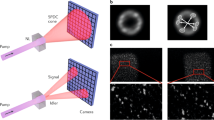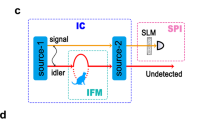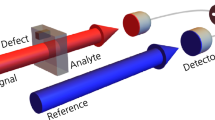Abstract
Information is central to quantum mechanics. In particular, quantum interference occurs only if there exists no information to distinguish between the superposed states. The mere possibility of obtaining information that could distinguish between overlapping states inhibits quantum interference1,2. Here we introduce and experimentally demonstrate a quantum imaging concept based on induced coherence without induced emission3,4. Our experiment uses two separate down-conversion nonlinear crystals (numbered NL1 and NL2), each illuminated by the same pump laser, creating one pair of photons (denoted idler and signal). If the photon pair is created in NL1, one photon (the idler) passes through the object to be imaged and is overlapped with the idler amplitude created in NL2, its source thus being undefined. Interference of the signal amplitudes coming from the two crystals then reveals the image of the object. The photons that pass through the imaged object (idler photons from NL1) are never detected, while we obtain images exclusively with the signal photons (from NL1 and NL2), which do not interact with the object. Our experiment is fundamentally different from previous quantum imaging techniques, such as interaction-free imaging5 or ghost imaging6,7,8,9, because now the photons used to illuminate the object do not have to be detected at all and no coincidence detection is necessary. This enables the probe wavelength to be chosen in a range for which suitable detectors are not available. To illustrate this, we show images of objects that are either opaque or invisible to the detected photons. Our experiment is a prototype in quantum information—knowledge can be extracted by, and about, a photon that is never detected.
This is a preview of subscription content, access via your institution
Access options
Subscribe to this journal
Receive 51 print issues and online access
$199.00 per year
only $3.90 per issue
Buy this article
- Purchase on Springer Link
- Instant access to full article PDF
Prices may be subject to local taxes which are calculated during checkout





Similar content being viewed by others
References
Feynman, R. P., Leighton, R. B. & Sands, M. The Feynman Lectures on Physics Vol. III, Chs 1 and 3 (Addison-Wesley, 1964)
Mandel, L. Coherence and indistinguishability. Opt. Lett. 16, 1882–1883 (1991)
Zou, X. Y., Wang, L. J. & Mandel, L. Induced coherence and indistinguishability in optical interference. Phys. Rev. Lett. 67, 318–321 (1991)
Wang, L. J., Zou, X. Y. & Mandel, L. Induced coherence without induced emission. Phys. Rev. A 44, 4614–4622 (1991)
White, A. G., Mitchell, J. R., Nairz, O. & Kwiat, P. G. “Interaction-free” imaging. Phys. Rev. A 58, 605–613 (1998)
Abouraddy, A. F., Stone, P. R., Sergienko, A. V., Saleh, B. E. A. & Teich, M. C. Entangled-photon imaging of a pure phase object. Phys. Rev. Lett. 93, 213903 (2004)
Gatti, A., Brambilla, E. & Lugiato, L. Prog. Opt. 51, 251–348 (2008)
Pittman, T. B. et al. Two-photon geometric optics. Phys. Rev. A 53, 2804–2815 (1996)
Aspden, R. S., Tasca, D. S., Boyd, R. W. & Padgett, M. J. EPR-based ghost imaging using a single-photon-sensitive camera. New J. Phys. 15, 073032 (2013)
Wiseman, H. M. & Mølmer, K. Induced coherence with and without induced emission. Phys. Lett. A 270, 245–248 (2000)
Elitzur, A. C. & Vaidman, L. Quantum mechanical interaction-free measurements. Found. Phys. 23, 987–997 (1993)
Kwiat, P., Weinfurter, H., Herzog, T., Zeilinger, A. & Kasevich, M. A. Interaction-free measurement. Phys. Rev. Lett. 74, 4763–4766 (1995)
Horne, M. in Experimental Metaphysics Vol. 1. (eds Cohen, R. S., Horne, M. & Stachel, J. ) 109–119 (Kluwer Academic, 1997)
Howell, J. C., Bennink, R. S., Bentley, S. J. & Boyd, R. W. Realization of the Einstein-Podolsky-Rosen paradox using momentum-and position-entangled photons from spontaneous parametric down conversion. Phys. Rev. Lett. 92, 210403 (2004)
Walborn, S. P., Monken, C. H., Pádua, S. & Souto Ribeiro, P. H. Spatial correlations in parametric down-conversion. Phys. Rep. 495, 87–139 (2010)
Tasca, D. S., Walborn, S. P., Souto Ribeiro, P. H., Toscano, F. & Pellat-Finet, P. Propagation of transverse intensity correlations of a two-photon state. Phys. Rev. A 79, 033801 (2009)
Horne, M. A., Shimony, A. & Zeilinger, A. Two particle interferometry. Phys. Rev. Lett. 62, 2209–2212 (1989); Two particle interferometry. Nature 347, 429–430 (1990)
Ribeiro, P. H. S., Pádua, S., Machado da Silva, J. C. & Barbosa, G. A. Controlling the degree of visibility of Young’s fringes with photon coincidence measurements. Phys. Rev. A 49, 4176–4179 (1994)
Abouraddy, A. F., Stone, P. R., Sergienko, A. V., Saleh, B. E. A. & Teich, M. C. Entangled-photon imaging of a pure phase object. Phys. Rev. Lett. 93, 213903 (2004)
Zou, X. Y., Grayson, T. P. & Mandel, L. Observation of quantum interference effects in the frequency domain. Phys. Rev. Lett. 69, 3041–3044 (1992)
Grayson, T. P. & Barbosa, G. A. Spatial properties of spontaneous parametric down-conversion and their effect on induced coherence without induced emission. Phys. Rev. A 49, 2948–2961 (1994)
Jellison, G. E., Jr & Modine, F. A. Optical absorption of silicon between 1.6 and 4.7 eV at elevated temperatures. Appl. Phys. Lett. 41, 180 (1982)
Khalaidovski, A. Steinlechner, J. & Schnabel, R. Indication for dominating surface absorption in crystalline silicon test masses at 1550 nm. Class. Quantum Grav. 30, 165001 (2013)
Malitson, I. H. Interspecimen comparison of the refractive index of fused silica. J. Opt. Soc. Am. 55, 1250 (1965)
Bass, M. Handbook of Optics Vol. 2, 2nd edn (Optical Society of America, 1995)
Acknowledgements
We thank M. Horne for reading the manuscript, clarifying suggestions and many discussions, P. Enigl for designing the figures for the objects, D. Greenberger and S. von Egan-Krieger for discussions, and C. Schaeff for equipment loans. Microfabrication was carried out at the Center for Micro- and Nanostructures (ZMNS) of the Vienna University of Technology. We acknowledge D. Ristanic for assistance with cryogenic Si etching and M. Schinnerl for contact mask production. G.B.L. was funded by the Austrian Academy of Sciences (ÖAW) through a fellowship from the Vienna Center for Science and Technology (VCQ). S.R. is funded by an EU Marie Curie Fellowship (PIOF-GA-2012-329851). This project was supported by ÖAW, the European Research Council (ERC Advanced grant no. 227844 ‘QIT4QAD’, and SIQS grant no. 600645 EU-FP7-ICT), and the Austrian Science Fund (FWF) with SFB F40 (FOQUS) and W1210-2 (CoQus).
Author information
Authors and Affiliations
Contributions
A.Z. initiated this research. G.B.L., V.B., R.L., S.R. and A.Z. designed the experiment. G.B.L., V.B. and R.L. carried out the experiment. G.D.C. fabricated the silicon and silica phase masks. All authors contributed to the writing of the manuscript.
Corresponding authors
Ethics declarations
Competing interests
The authors declare no competing financial interests.
Extended data figures and tables
Extended Data Figure 1 Visibility of the experiment.
The count rates were recorded with the path D1–D2 both unblocked (red dots) and blocked (blue squares) as the relative phase between the transmitted and reflected beams of the PBS was varied. The red line is a sine curve fit for the experimental data giving (77 ± 1)% visibility. The error bars are smaller than the size of the data points.
Extended Data Figure 2 Excluding induced emission.
Shown are the count rates for 810-nm photons produced in NL2 when the path between D1 and D2 was blocked (blue crosses) and unblocked (red dots). The blue diamonds show the ratio of the count rates for the blocked and unblocked configuration. The linear fit for this data (black line) gives an angular coefficient of (2 ± 4) × 10−5 (mW)−1.
Rights and permissions
About this article
Cite this article
Lemos, G., Borish, V., Cole, G. et al. Quantum imaging with undetected photons. Nature 512, 409–412 (2014). https://doi.org/10.1038/nature13586
Received:
Accepted:
Published:
Issue Date:
DOI: https://doi.org/10.1038/nature13586
This article is cited by
-
Generation of infrared photon pairs by spontaneous four-wave mixing in a CS2-filled microstructured optical fiber
Scientific Reports (2024)
-
Interaction-free, single-pixel quantum imaging with undetected photons
npj Quantum Information (2023)
-
Quantum enhanced non-interferometric quantitative phase imaging
Light: Science & Applications (2023)
-
Correlated-photon imaging at 10 volumetric images per second
Scientific Reports (2023)
-
Remote transport of high-dimensional orbital angular momentum states and ghost images via spatial-mode-engineered frequency conversion
Nature Communications (2023)
Comments
By submitting a comment you agree to abide by our Terms and Community Guidelines. If you find something abusive or that does not comply with our terms or guidelines please flag it as inappropriate.



